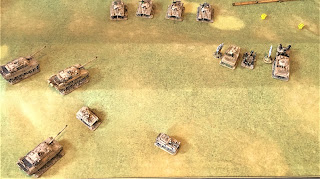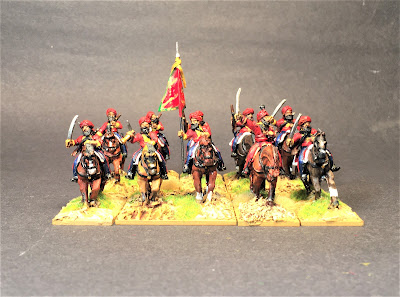So which is which and why?- and do we really care?
First question. Is there really any difference between the three.?
Honestly no not really, but well, yes sort of possibly.
First, speaking personally, I simply prefer the term 'retro' for a certain style of wargaming to the term 'old school' because for me 'old school' has certain connotations. First I hated the bloody place and was glad when - many years later- I found out that some bright fella had run a bull dozer through it immediately making that part of Greater Manchester a better place. Secondly because a chap once told me that 'old school' wargaming remined him too much of cardigans, Ralgex and Werthers originals. I won't say he was wrong.
 |
| Definitely both 'old school' and 'retro'. ECW guns one part of Peter Gilders collection. They were called 25mm when they were made |
So, for me the two terms 'old school' and 'retro' wargaming are rather similar though it depends - as always- on your individual view.
Now I began wargaming at the aforementioned Grammar School in 1970 which was a while back and definitely 'old school' by today's standards. Armies were mostly Airfix with a few very precious Les Higgins, then a little later Hinchliffe. Rules were Featherstone or Wise, then London Wargames section Napoleonics. or awful home written concoctions. I recall writing rules for the Indian Mutiny. They must have been awful since we had bugger all knowledge about how mid 19th century battles were conducted and not much more knowledge about how the armies were organised. or looked.(So a bit like some modern 'game designers' then!)
 |
| Modern Old Glory 28mm Napoleonic painted by James Main for a client who wanted them in a 'retro' style. |
By 1974 or thereabouts I had joined the Manchester Area Wargames Society whose members were actually adults and owned wholly metal armies. Rules were still often homegrown but WRG had made its appearance and compared to the school club stuff was complicated but there were more periods- I saw my first ECW game at one of the meetings.
Once I moved up to the North-East, despite a brief dalliance with the rules published by Derek Sharman- which used a 'spinner' rather than dice for the 'random factor' then for the next few years it was mostly WRG all the way Ancients and Pike and Shot.
 |
| Old Glory 28mm AWI 'Modern' style? |
All of this is in many eyes 'old school' - but when you try to find out what MAKES it 'old school' the answers all differ depending upon the age of and time in the hobby of, the person being asked. Often 'old school' seems to mean' what happened before I joined in' or 'different from what I do now ' or even 'not as much fun cos you had to know stuff '. 'old school 'perhaps but it is 'retro' ?
 |
Indian Mutiny - mutineers Old Glory 28mm organised for Young and Lawford's 'Charge - or How to play Wargames' a 1960s rule set which I still find useful for smaller battles.
|
For myself I tend to use the term 'retro' more for the look of the table and the figure collection than for any other reason. Yes rules come into it somewhat but I can set up a retro looking game and use 'modern' rules- though I'm not sure why I would do this as many 'modern' rules are overly wordy- sometimes close to 'barkerese' that I can't be bothered to spend the time puzzling them out or sorting out the useful bits in the overly pretty eye candy filled book. No always true but of modern style rules I have bought in the last 3 or 4 years only 'In Deo Veritas' for large Pike and Shot battles in smaller scales has made sense in less than 4 or 5 readings- but I don't really want to go into 10mm- though I will keep bending Jim's ear in that direction ! (He already has a bundle of 10mm SYW)
 |
Some of my deliberately 'retro' 30mm collection with some of the plastic trees.
|
Mind you I HATE reading rules. The often arcane language is very off putting 'roll 97 22 sided dice in alternate non -sequence while standing on one leg with a haddock in the left hand - then mark down one or possibly 2 casualty points but no more, then roll the 18 sided dice 13 times to decide your first unit's movement' - yes I exaggerate rather more than somewhat- but many modern rules do seem very dice heavy, seemingly replacing thought and decision making by dice rolling. If I wanted to plat a dice based game I'd play snakes and ladders.
Ok , after that digression, back to the plot. The easiest way to spot what might be a retro game is the look- gloss varnish on the models is a good start and then possibly the make of models- Minifigs possibly or Garrison or Hinchliffe or Stadden or Hinton Hunt or Les Higgins or Lamming or possibly even more obscure makes such as Corvus or Vulcan.
It is also not difficult to mix the styles. My Indian Mutiny collection are all modern figures painted in a 'modern' style with matt varnishing are singly based and will be used for a 'Charge! variant- said rules by Young and Lawford being definitely 'old schll' since they were published for the first time in the late 1960s but I can also use them for such modern sets as 'The Men Who would be Kings' assuming I can get those rules to fit the Mutiny without destroying any period feel.
Does the owner of said, old lead dudes refer to them as 25mm rather than the 'cool' 28mm which is so old it dates from as long ago as the the mid 1990s. For the record two of my own retro projects are in 30mm - just to confuse the issue..
I've also been told that 'old school' rules are more complicated 'all those tables and stuff' or indeed that they are very simple- by which they usually mean over simple really, once again old school seems to mean 'what I don't want' or even 'what I like' depending upon who you speak to.
One thing might be close to a constant 'old school' types are often more likely to question the rules and bin them if their own knowledge tells them said rules are garbage. On that score I am definitely 'old school' . Slavish obedience to 'da rools ' at the expense of the history is for fantasy dudes and games slaves, not open minds. Mind you there was a lot of that kind of stuff back in the day so maybe that is old school too!
Now my collection of plastic trees are definitely old school- they take pride of place in my retro games and sometimes turn up in the 'modern' style too. For a start they don't scatter flock everywhere like the bog brush trees you often see. But I'm glad I bought most of them in the 1970s as they tend to work out at around 20 quid each for the larger specimens on ebay these days.
It also seems that in ye olden days- depending on how far back that actually is- units were often larger- see Grants 5 officers and 48 man infantry units wheras today a 24 figure unit is not infrequently touted as 'standard' but then so is '4 bases' in rules where the models are often no more than counter decoration- but then even that is in some eyes 'old school' - Phil Barker opined almost exactly that is several of his rule sets back in the 1970s.
So my point really is- beyond the look of the thing- is there really any such thing as 'old school' or is it really merely 'doing it my way' rather than merely being a consumer of the latest gaming fad.
For myself I will always prefer 'historical period' to 'gaming fad'.
So even the way I buy into any new (for me) period might be 'old school' it usually goes ' That's interesting'- himm what models are available- how do I want to present them on the table?- ok what rules can I use?- Which ones are any good, and will I lose the will to live trying to read the bloody things (reading rules can kill my interest in a period faster than any other single thing). Rule are always at the bottom of the thought chain I have often bought and even painted the armies before I have thought about rules.
I suppose that makes me old school' then ... or does it?


















































